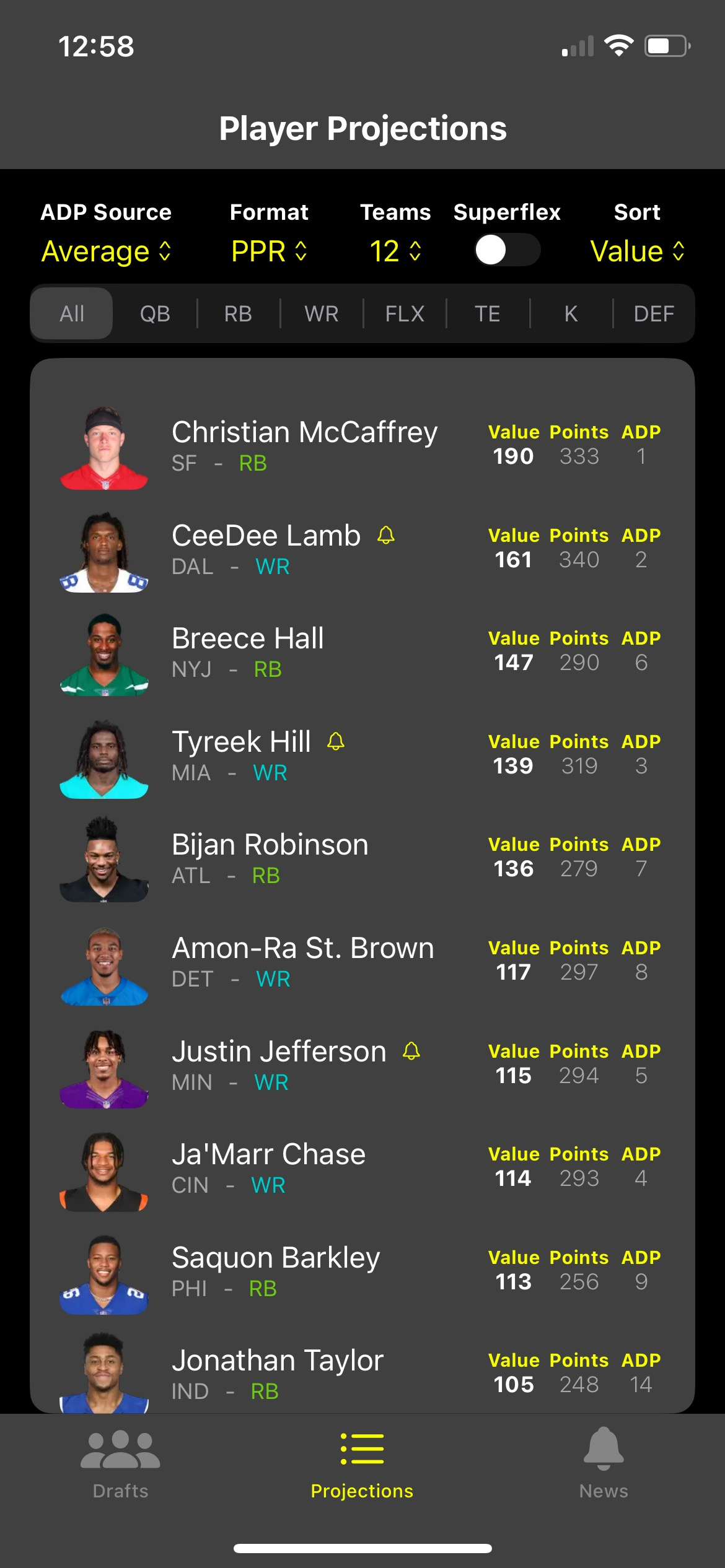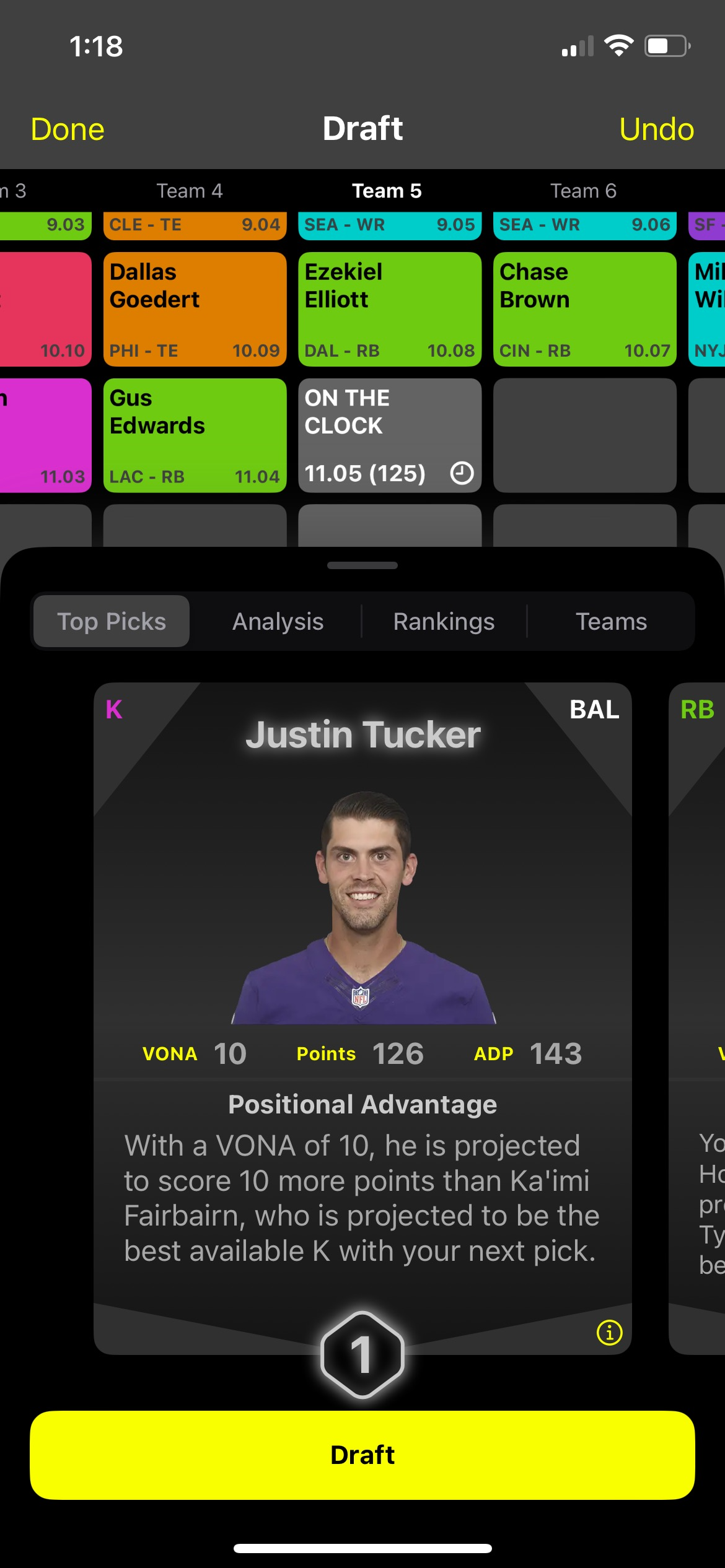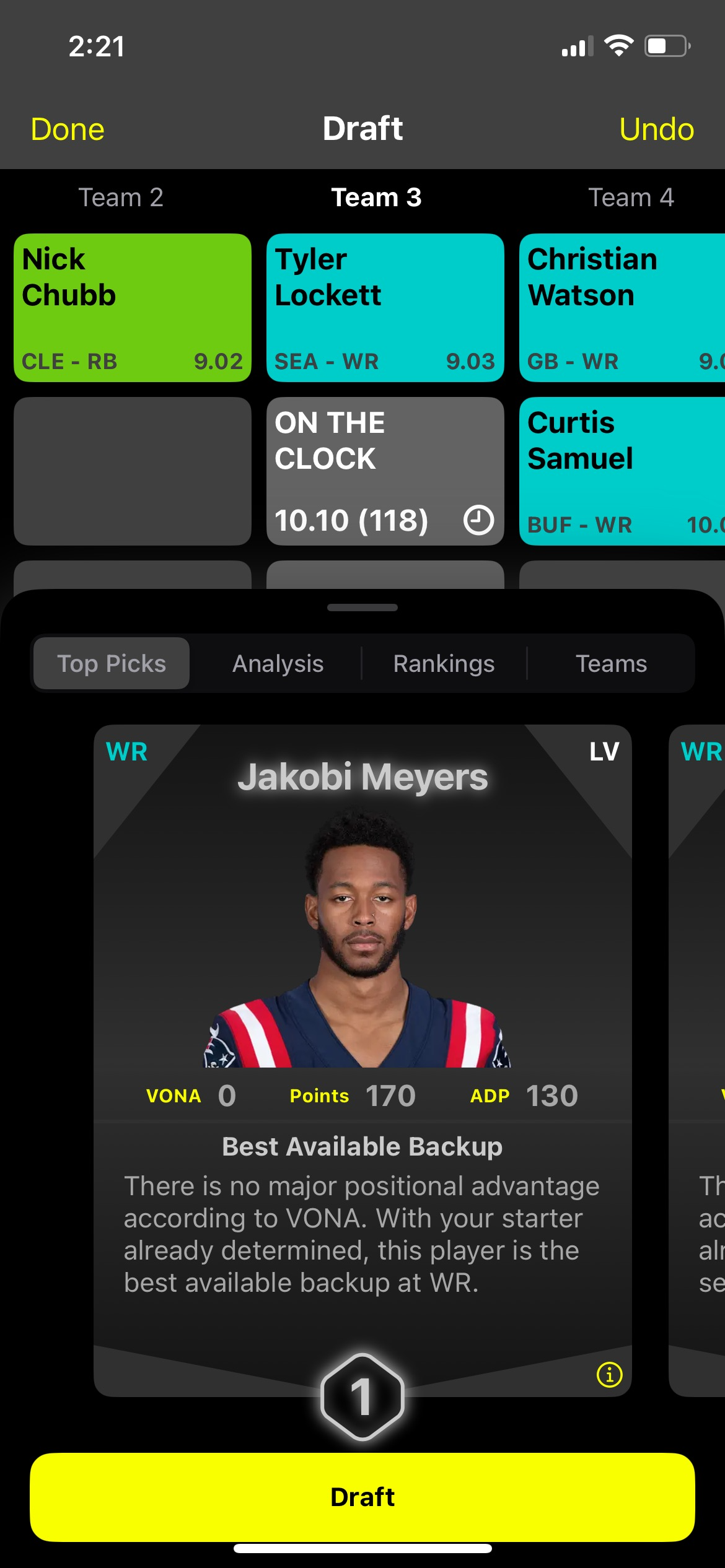Since the dawn of fantasy football, we have all been trying our best to identify the perfect draft strategy. After years of experimentation with different strategies, I would like to highlight today what I consider to be the best, Value Based Drafting (VBD). More specifically, I will single out the strategy Value over Next Available, or VONA.
The road that lead me to VONA was long and arduous, but it eventually paid off in the culmination of a new VONA-based drafting app, PerfectPick.
I will frequently reference decisions made for PerfectPick in relation to how to enable the full potential of VONA. Outside of a shameless plug, I do hope it gives a clear example of how someone may really try to get the most out of this draft strategy.
Value Based Drafting (VBD)
VBD is all about assigning a “Value” to a player. This requires a few steps:
- Determine projections for each player, resulting in an estimated point output.
- Establish a comparison. Most “Value” calculations pick a baseline player at the position, based on a pre-determined rank at that position.
Here's a visual representation:
| Position | Player | Projected Points | Baseline Player | Baseline Points | Value |
|---|---|---|---|---|---|
| WR | Puka Nacua | 275 | Jaxon Smith-Njigba | 179 | 96 |
| RB | Kyren Williams | 236 | Gus Edwrds | 143 | 94 |
At first glance, you may see Puka Nacua with 275 projected points and Kyren Williams with 236 projected points, and be led to believe that Puka has an extremely clear advantage over Kyren. However, further analysis shows that elite WRs always output more total points than elite RBs. The important metric is not their total points, but how many MORE points at their position do they generate than the average, or BASELINE player.
Therefore, after comparing to baseline players, we can see Puka has a Value of 96 and Kyren with a Value of 94. These players are just about equal in their positional advantage.
This is a great place to start. Using this simple approach, you can then generate rankings that use this “Value” to compare a player’s worth across the different positions. Take this screenshot from PerfectPick, which uses this “Value” as the basis for rankings:

While this is extremely useful in determining general rankings, and comparing one player to another, it starts to become lackluster in an actual draft. In can be hard to take this information and translate it into an actual pick. Well, this is where Value over Next Available, or VONA, steps in.
Value over Next Available (VONA)
As shown in VBD, establishing a value is a great way to compare players against each other, both within the same position group and between position groups. But how do I translate this into an actual pick?
Well, this is why we have VONA, or Value over Next Available. With a VONA based strategy, the biggest difference is the choosing of what player represents the value “baseline”. In this strategy, the baseline player becomes the player who would be the best available player, at the same position, with your NEXT pick.
Here's an example from the Analysis screen in PerfectPick. In this situation, the user is choosing a pick in the third round, pick 3.05. Therefore, we compare against the best player that will be a available at each position in the fourth round, pick 4.08.

This comparison allows you to determine the worth of a player at each position, if you were to take them RIGHT NOW. So you can easily say something like, “If I take Jalen Hurts right now, I am gaining 35 points in value at this position“. Comparing this to other positions, you would only gain 11 points at RB and WR. At TE, the best TE is predicted to still be available at your next pick, therefore the TE position has a VONA of 0. Based on this analysis, it's clear that taking a QB with the third pick is the best value.
Historical wisdom may tell us "don't draft a QB early", fullstop. However, as the previous analysis shows, a VONA analysis cuts through any predisposition, and only focuses on facts.
Take a look at another example. Historical wisdom may also tell us to draft a Kicker in the last or second to last round. Again, VONA cuts through these historical assumptions, only focusing on the present situation:

In this example, Justin Tucker is predicted to not be available in the 12th round (15 total rounds). Therefore, in order to gain a 10 point advantage at the kicker position, it is recommended to draft Justin Tucker in the 11th round.
So again, the power of VONA is that we are able to analyze our current situation, in this unique year at this unique pick, rather than being confined by drafts of old that had each of their own peculiarities. Things that may have been considered naive in the past, like drafting a kicker a few rounds early or taking a QB in the first 3 rounds, may now be considered a smart decision.
It's time to leave our preconceptions at the door and let data drive our decision making.
VONA is Not Easy
Even if you are convinced by now that VONA can be an acceptable strategy, you may have started to notice how complicated it can get. Particularly with the following items:
- Accurate Projections Needed
- How to Predict Opponent Picks
- How to Perform Calculations Mid Draft
Accurate Projections Needed
Unfortunately, every draft strategy out there is limited by the accuracy of the projection data that fuels it, and VONA is no exception. There are many options out there between aligning with a single expert, calculating your own projections, or using consensus expert data such as ECR. However, my favorite and only acceptable solution has recently been to take an average of projections, weighting them based on historical accuracy.
Picking one expert to align with will always result in amazing home runs but also colossal mistakes. Taking the average is the most consistent and reliable strategy for projections. The PerfectPick app does exactly this for its stat and point projections. Projections are taken from many sites and many experts across the field, and then these projections are weighted based on historical accuracy.
This topic actually deserves a whole discussion of its own, which I will be covering in a future post.
How to Predict Opponent Picks
By now you know that VONA requires predicting the next available player at each position for your next pick, but how is this done? Average Draft Position, or ADP, is a metric that lists the pick a player is typically being drafted. Therefore, this is the primary metric used in determining an opponent’s pick in PerfectPick. Determining which ADP to use is extremely important. Similarly to accurate projections, an average is most suitable when drafting against a general population.
However, if you know the population you will be drafting against, such as when drafting on ESPN or Yahoo, it is most advantageous to use ADP data from that site specifically. For this reason, PerfectPick allows the selection of an ADP Source, either the average or one of the supported sites. By having ADP data specific to your competition, you can make the most accurate opponent pick predictions.
At the time of writing this post, PerfectPick supports the following ADP Sources: ESPN, Yahoo!, FantasyPros, Sleeper, BB10s, and NFFC.
Needless to say, ADP can’t be the only driving factor, which is why things such as positional needs must be taken into account as well.
How to Perform Calculations Mid Draft
There's no surprise that this amount of calculation can be intimidating in the middle of a draft, especially when on the clock. I have tried many methods over the years, between pen and paper, personal spreadsheets, and existing applications/web tools. Personally, none of them quite lived up to my expectation, and that drove me to where we are today, with the creation of PerfectPick.
As mentioned though, PerfectPick is not the only option. No matter what method is chosen, this undoubtedly is a draft strategy that requires preparation and assistance. It is this reason that I think it VONA is overlooked as the primary strategy for most people in their live drafts. But hopefully as our tools improve, so does the widespread use of advanced strategies such as VONA.
Limitations
It would be dishonest to not also mention the drawbacks of VONA. Although I find there to be few drawbacks, I want to highlight the following:
- VONA does not directly take positional need into account
- What happens when VONA between positions is the same
VONA does not directly take positional need into account
Although VONA is an amazing stat to use mid draft, there are of course other factors at play, most importantly the current positional need of your drafted team. This is why PerfectPick’s algorithm does not strictly use VONA for its pick recommendations. Instead, positional advantage is used in parallel with the VONA calculation at each position to determine the best actual pick for each round.
What happens when VONA between positions is the same
Of course, we must ask ourselves what to do when the VONA between positions is about the same. This most notably happens in later rounds, when players across the board have similar projections and the elite players have already been chosen.
In PerfectPick, when the VONA between multiple players is negligible, we fall back to more primitive methods, such as: positional needs, boom/bust potential, etc. Here's an example:

Thus, there is no perfect answer here. In some cases, it may be clear you are lacking strength at one position and you can simply draft the best available. In other cases, it may make sense to take a shot on a high boom high bust player, just to use this pick as a shot in the dark.
Summary
This merely scratches the surface of VONA, but I hope it has at least given some insight into this lesser known strategy and its advantages.
I personally do think it is the best strategy and have seen immediate payoff after switching. I hope this helps you win your leagues too!
Discuss on Reddit
Discuss on Twitter